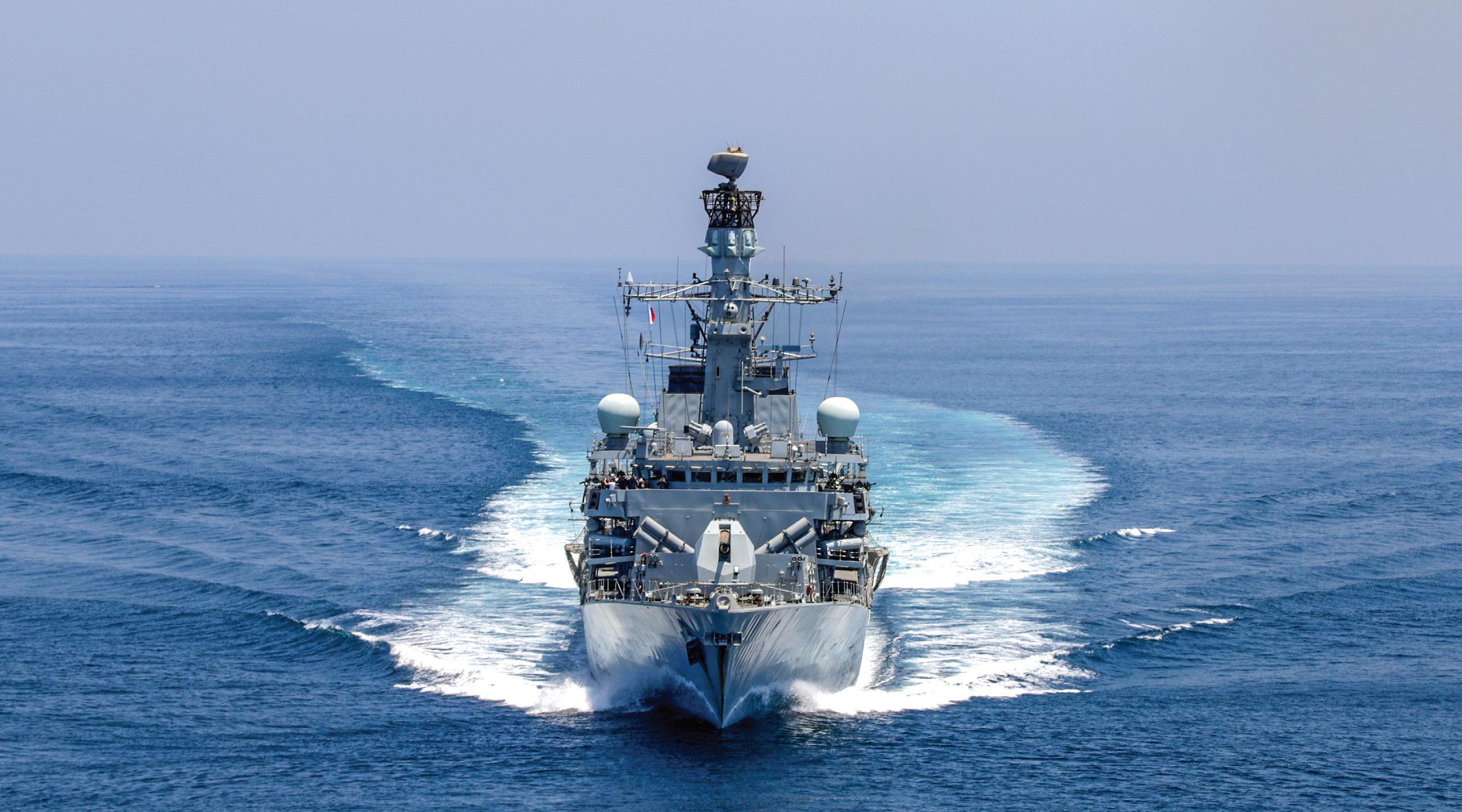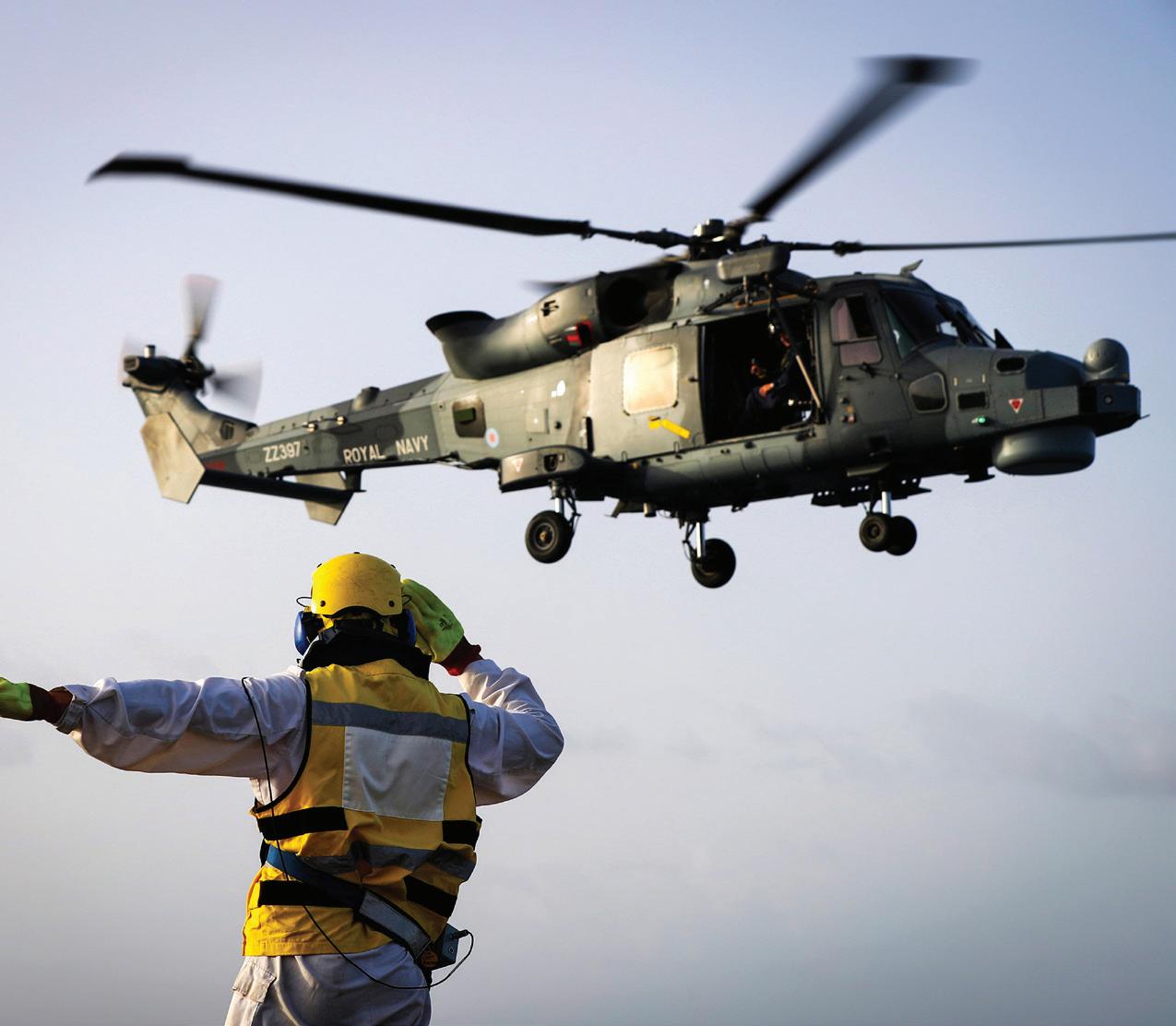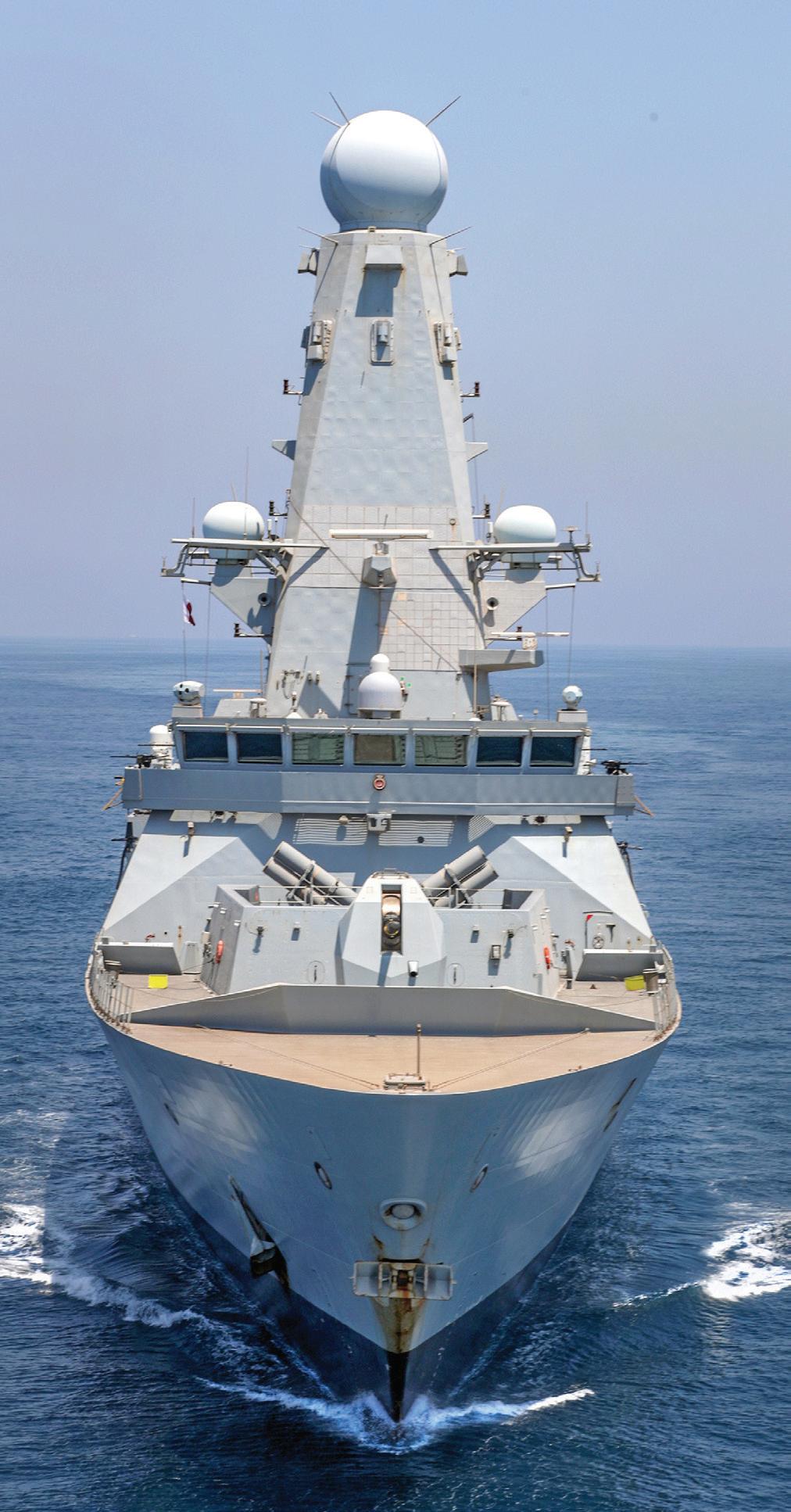
5 minute read
DEFENCE IN DEPTH
DEFENCE IN DEPTH
Captain Nick Walker, formerly of the of the Royal Navy’s Carrier Strike and Aviation team, explains to Simon Michell how a Carrier Strike Group is able to defend itself on operations.
Naval warships are designed from the outset to be able to sail to a problem and deliver a solution, offering a range of responses from armed intervention to diplomatic influence. The ultimate expression of this power projection is the flexible, versatile and globally deployable Carrier Strike Group (CSG). Nothing has the ability to concentrate an adversary’s mind more than the imminent arrival of a flotilla of heavily armed ships with, at its core, an aircraft carrier: a well-found aviation operating base capable of projecting power through its air group, consisting of fast jets and attack, surveillance, and support helicopters.
In times of tension or conflict, an adversary may try and counter the potency of the CSG through direct attack. As a result, a CSG has to defend itself against a wide spectrum of threats. Capt Nick Walker, who has flown from and sailed in all three of the UK’s previous Invincibleclass carriers and has held the position of commander air, explains, ‘There is no primary threat, but a range of dangers depending on where you are operating and what type of opposing force you are likely to encounter’. According to Walker, at least for the time being, the potential for a CSG squaring up to another large fleet on the high seas is remote. That does, however, leave a raft of other dangers to consider. Walker goes on, ‘Potential adversaries could employ a combination of submarines, surface ships, and aircraft against the CSG’. Added to that, depending on how close you are to an adversary’s coastline there is also a threat from land-based missile and coastal defence systems as well as small fast-attack craft. Most recent attacks on warships have been from a mixture of conventional and asymmetric assaults. The attack on the American guided-missile destroyer USS Cole in 2000 was prosecuted by a small fibreglass boat filled to the brim with explosives. Some 16 years later, another US guided-missile destroyer, USS Mason, launched countermeasures as it was sailing near the Bab el-Mandeb Strait to fend off a putative cruise missile attack. In February 2017, the Saudi Arabian frigate Al Madinah was hit by an unmanned speedboat that exploded on impact. More recently, in June 2018, Houthi Rebels are reported to have fired missiles from the port of Houdeidah at a Saudi-led naval contingent, hitting one of the warships.

Pictured here is the Type 23 frigate HMS Montrose. Anti-submarine warfare weapon systems and sensors enable Type 23 frigates to defend against torpedo attack.
Royal Naval Photo By LPHOT Rory Arnold, Crown Copyright
Integrated defence
A proven way to counter the gamut of possible threats is to use an integrated, or layered, defence consisting of submarines, frigates, destroyers and their embarked helicopters, together with the carrier air group supported by land-based aircraft where access permission has been granted by a host nation. These elements operate both defensively and offensively at varying distances to create outer, medium and inner cordons. ‘Ideally, we will engage or negate threats at range, and because the threats can be diverse you need different capabilities to counteract them’, explains Walker. For example, Type 23 frigates and Type 45 destroyers can both neutralise threats from surface vessels, but the frigates specialise in anti-submarine warfare and the destroyers in air defence. Submarines can also target a surface vessel, and as Walker points out, ‘an enemy submarine may best be neutralised by one of our own submarines’.

A Royal Navy Wildcat helicopter from 815 Squadron. Wildcat helicopters are able to chase down fast attack craft and neutralise them before they can reach their target.
Royal Navy Photo by LPHOT Steve Buke, Crown Company
The CSG associated aircraft, based on the carrier and her escorts, also have specialisms. The Queen Elizabeth-class carriers’ F-35B fast jets represent the very apex of air-to-air and air-to-surface capability. This fifth-generation aircraft also has a suite of incredibly advanced sensors able to search for potential threats. Merlin HM.2 helicopters have the world’s most modern equipment designed specifically to seek out and destroy submarines. This is true of the Royal Air Force’s recently acquired P-8A Poseidon maritime patrol aircraft, which can be added as an additional layer if necessary once it achieves initial operating capability in April 2020. Wildcat HMA.2 helicopters have anti-surface vessel and ASW weaponry and are particularly adept at chasing down the sort of fast-attack craft that attacked USS Mason and the Royal Saudi Arabian Navy frigate. Merlin Mk. 4 ‘Junglies’ can also be used to transport Royal Marines ashore, and conduct stores movements and Joint Personnel Recovery should someone need rescuing.
The innermost layer consists of smaller calibre armaments, and in the case of HMS Prince of Wales include the Phalanx close-in weapon system, miniguns, and general purpose machine guns (GPMGs). Phalanx, an automatically controlled anti-missile cannon, can also down a fast jet if it manages to get through the outer cordons. The miniguns and GPMGs are shorter-range guns invaluable for keeping smaller boats and fast-attack craft at bay.
Cyber defence
As well as physical threats, any CSG also has to factor in cyber warfare. This is a relatively new discipline and not as well understood as more traditional methods of attack. As Walker points out, ‘The totality of a concerted cyberattack against a maritime task group is challenging to quantify’. However, military systems have an advantage over commercial or civilian systems as they are designed to be able to sustain damage through redundancy and continue to operate in contested cyber environments through agility and the application of advanced technology. If a part of a system or network is neutralised there is an alternative way of completing the task at hand. ‘We design and build in as much redundancy as possible. For example, we build into communication and control systems the ability to be agile – hopefully more agile than the cyber attacker’, says Walker. Equally, we may employ our own technology to disrupt enemy capabilities, rendering them ineffective.

An F-35B lands after deploying the first Paveway II bombs from HMS Queen Elizabeth. The F-35B Lightning represents one of the most formidable defence elements of any QEC task group.
Royal Navy Photo By LPHOT Kyle Heller, Crown Copyright
Intelligence-led defence
The most ubiquitous element in the defence network is the Royal Navy’s intelligence-led threat analysis. ‘The preparation for every deployment – even routine peacetime deployments – involves thorough intelligence analysis to understand potential threats before we deploy’, explains Walker. This highly detailed assessment informs the planners as to the optimum protective formation required. Threat levels are different depending on where the deployment will operate. Therefore, if a particular threat is more prominent, the protective layers are tailored accordingly.

The Type 45 destroyer HMS Duncan protecting shipping lanes in the Arabian Gulf. The Daring-class Type 45 destroyers specialise in protecting maritime task groups from air attack.
Royal Navy Photo by LPHOT Roy Arnold, Crown Copyright
There is not a single formation that applies to each deployment. Sometimes it may not be possible to deploy one of the protective layers, particularly if it requires overseas host-nation support, but this does not mean the deployment can’t take place. What is true, though, is that there is an irreducible minimum level of protection. As Walker confirms, ‘We don’t tie the carrier to a set level of defence, but we will always make sure the CSG has the right level of protection and the right capabilities for where it is going and how it is going to be used’.










